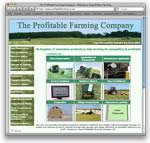 |
|||||||||
|
|||||||||||||||||||
At LAMMA, the Profitable Farming Company announced the introduction of a new data tagging version of its BALER’S CHOICE Automatic Preservative Application system for big balers, that will enable a wealth of information on individual hay and straw bales to be recorded and stored.
The new unit is designed around a central base unit and communication hub, to which various modules can be added. This system means that the BALER’S CHOICE application unit can be specified to meet a specific need, with the flexibility that additional modules can then be added at a later date to upgrade the system. Base Unit At the heart of the Automatic system is the BALER’S CHOICE Communications Hub, the Model 465 Touch Screen control unit and twin moisture-sensing Star-Wheels with speed sensors in the bale chamber. As the bale passes through the bale chamber, these Star-Wheel sensors record both the moisture content of the bale and the speed of baling. The information on each bale is passed to the Communications Hub and the cab mounted Touch Screen control unit where it is then collated and stored. This Base Unit can be used just as a ‘stand-alone’ unit to simply monitor aspects such as moisture content and speed of baling as tonnes per hour output. 1st Module – The BALER’S CHOICE Automatic Application System To take the system a stage further, the 1st Module comprises everything that is needed to automatically apply BALER’S CHOICE preservative at moisture contents of between 16% and 27%. Included in the module is a 400 or 440 litre tank, the three-pump applicator unit and the spray nozzle shield that is located above the pick-up. Using bale moisture and speed information from the Star-Wheels, when the moisture content of the material being baled rises above 16%, the applicator unit will automatically alter the application rate every three seconds, switching individual pumps on or off to give a range from 1.9 litres up to 4.7 litres per tonne depending on moisture content up to a maximum of 27%. 2nd Module – The NEW BALER’S CHOICE Data Tagging unit
The unique new BALER’S CHOICE Data Tagging system brings baling into the 21st Century and enables the operator to record a wealth of information on every bale made. To achieve this, as the bale passes through the chamber, the Data Tagging unit lifts the bale string and applies a tag to each bale that contains a Radio Frequency Identification (RFID) microchip. As the bale exits the chamber, it passes under an antenna which uses a radio frequency to transmit specific bale information to the antenna embedded in the tag, where the information is then stored in the tag’s microchip. This includes:
In addition, this information is also saved by the system and can be subsequently downloaded via a USB connector and saved as an Excel spreadsheet, giving to provide a permanent printed record of each bale made. 3rd Module – The BALER’S CHOICE GPS Unit The GPS Unit takes baling to a new level as it allows the operator to both monitor and record yield differences across the field, but also in conjunction with the tagging unit, accurately record exactly where the bale was made. As with yield mapping for cereal crops, being able to record yield differences, this information can then be used as the basis on which to more accurately manage nutrient inputs, with both financial and environmental benefits. Bale tag readers In order to view the information contained on the tags, a hand-held or loader-mounted RFID tag reader is required. The tag on the bale transmits its information to a receiver in the reader, which translates the information and displays it on a screen. A push-button keypad can be used to navigate bale information and to sort and group bales, or to accept or reject bales based on the operator’s criteria. The hand-held unit will read one bale at a time from a distance of up to 1.5 metres. The tag does not have to be visible to be read. An attachment kit is also available for the hand-held reader that allows it to be mounted in the cab, where it can display information from antennas positioned on the loader. These antennas can read two bales at a time from up to 3.0 metres away. The benefits of Data Tagging bales The benefits from being able to record and store data on the hay and straw bales made are numerous:
BALER’S CHOICE preservative The BALER’S CHOICE preservative is suitable for use on hay, but also after the last couple of wet summers has increasingly been used on straw to ensure quality bales. BALER’S CHOICE uses a buffered form of propionic acid which has a near-neutral ph of 6.0, making it safe to handle and will not damage machinery. Propionic acid is well recognised as being an extremely effective bale preservative that when applied to hay or straw baled at higher moisture contents, ensures that mould and dust does not develop, but also avoids the heating that would otherwise occur. BALER’S CHOICE also contains citric acid to ensure that baled material remains fresh and palatable.
|
|||||||||||||||||||

|
|||||||||||||||||||
| home | agri-services | pedigree
pen | news | dairy | beef | machinery property | organisations | site map |
|||||||||||||||||||


